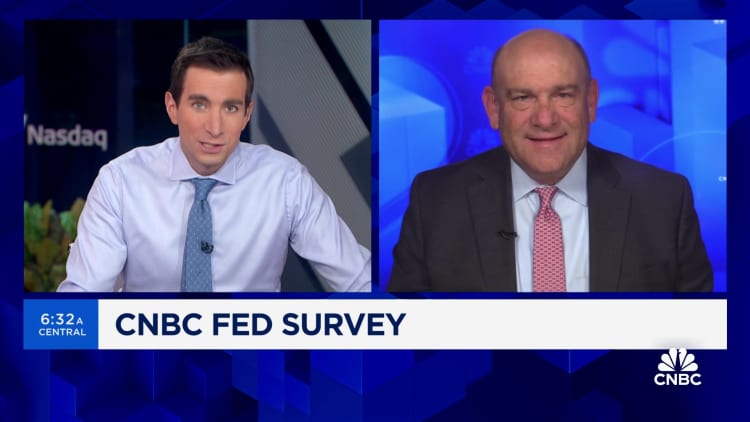
The Federal Reserve should keep credit conditions tight for now.
Source link
cutting

Morgan Stanley is cutting hundreds of wealth-management positions, including some managing directors, in one of new Chief Executive Ted Pick’s first major moves since taking over six weeks ago, according to a source familiar with the bank.
The layoffs mark an effort by Morgan Stanley
MS,
to contain costs. They will impact less than 1% of the roughly 40,000 employees in the marquee investment bank’s wealth-management unit but won’t include key client-facing staff, the source said. Morgan Stanley will begin to notify affected employees as early as this week.
The move was initially reported Wednesday by the Wall Street Journal.
The job cuts are taking place under Pick, an insider at the bank who took over as CEO on Jan. 1, succeeding longtime leader James Gorman.
Morgan Stanley’s wealth-management revenue remained about flat in the fourth quarter at $6.65 billion, compared to $6.63 billion in the year-prior period.
The bank reported 80,006 employees as of Dec. 31, down from 80,710 in the third quarter.
Morgan Stanley’s stock was up fractionally on Wednesday. The stock is down 9.9% so far in 2024, compared to a 4.3% gain by the S&P 500
SPX.
Jonathan Swartz contributed to this report.
Group 1 Automotive cutting 10% of U.K. jobs on losses in its used-car sales

Group 1 Automotive Inc. said Wednesday it will reduce its U.K. workforce by 10% or roughly 358 people as the latest company to cut jobs to reduce costs in the face of an uncertain economy.
Group 1 also warned it expects losses on used-vehicle wholesale sales in the U.K. to continue into the current quarter, which ended March 31.
The Houston-based auto dealership and collision-repair company also fell short of analyst estimates for fourth-quarter profit as costs rose, but it posted a slight beat on revenue.
Group 1’s stock
GPI,
rose 2% to $282.29 on Tuesday. It was not trading in the premarket on Wednesday. The stock has fallen by 7.4% so far in 2024, compared to a 3.3% rise by the S&P 500
SPX.
While Group 1’s U.S. operations have executed well in an “evolving” market, its U.K. unit experienced challenges with used vehicles, said Chief Executive Daryl Kenningham.
Group 1 said it recognizes that “we have some work ahead of us to bring our costs back in-line with recent trends.”
Based on 3,487 U.K. jobs disclosed in its annual report, Group 1
GPI,
will reduce its head count by about 348 people out of a total companywide head count of 15,491 employees. Out of that total, the auto dealer and collision repair specialist employs 12,004 workers in the U.S.
A company spokesperson did not immediately reply to a query on an exact head-count-reduction figure.
The company’s fourth-quarter profit fell by 30.3% to $106.2 million, or $7.87 a share, from $152.4 million, or $10.76 a share, in the year-ago quarter.
Adjusted earnings in the latest quarter were $9.50 a share, below the FactSet consensus estimate of $10.44 a share.
Revenue rose 10% to $4.48 billion, ahead of the analyst estimate of $4.41 a share.
While new-vehicle units rose by 14.8%, margins fell due to higher selling, general and administrative expenses (SG&A).
SG&A as a percentage of gross profit increased 7.5% in the U.K., driven by higher expenses and lower margins on both used and new cars, the company said.
“Our U.K. operations began a rebalancing of our used vehicle inventory in response to market changes, which generated losses on used vehicle wholesale sales in the current quarter, which are expected to continue into the quarterly period ended March 31,” the company said.
Fed to start cutting rates midyear in 2024 with high chance of soft landing, CNBC Fed survey finds

Rate cuts, an increased chance of a soft landing and lower inflation — the outlook for next year is looking up in the CNBC Fed Survey, to a point.
Respondents to the CNBC Fed Survey see the Federal Reserve beginning rate cuts next year, though not as aggressively or as quickly as markets have priced in. June is the first month for which more than half of respondents have a reduction built in, rising to 69% by July. Overall, the average respondent forecasts about 85 basis points of cuts next year, roughly one 25 basis point trim a quarter, but not as much as the 120 basis points built into futures markets.
“The Fed needs to begin laying out a road map to rate cuts that may represent tighter policy since cuts will be lagging the decline in inflation and real rates will be rising,” writes John Ryding, chief economic advisor to Brean Capital, in response to the survey.
Kathy Bostjancic, chief U.S. economist at Nationwide, writes in, “The markets have prematurely priced in high odds of rate cuts starting in Q1, but we do expect further steady disinflation will lead the Fed to begin rate cuts around mid-year.”
Like the Fed itself, the 35 respondents to the survey, including economists, strategists and analysts, separate into hawks and doves on the issue of rate cuts next year.
“I still believe (Powell) has the memories of the 1970s in his mind and will be more stubborn in keeping monetary policy tight for longer than markets want him to be,” said Peter Boockvar, chief investment officer at Bleakley Financial Group.
But Michael Englund of Action Economics writes in, “The U.S. headline y/y inflation metrics will fall sharply into early-2024 thanks to weakness in energy prices and easier comparisons, leaving the Fed with significant elbow room to start tightening even if core year over year inflation rates remain firm.”
Soft landing chances
Respondents boosted the probability of a soft landing to 47%, up 5 points from the October survey. They lowered the probability of a recession in the next year by 8 points to 41%, the lowest since the spring of 2022.
Still, the average respondent sees the unemployment rate rising to 4.5% next year and gross domestic product coming in just below 1%, or about half of potential, showing that all is not rosy with the forecast and that an economic slowdown remains the baseline forecast for the group.
“A softening in hiring, income growth, and confidence all point to reduced consumer and business spending,” says Joel Naroff of Naroff Advisors.
But Diane Swonk, chief economist at KPMG, writes in: “The U.S. consumer has proven itself a worthy adversary to everything the Fed has dealt it in its fight against inflation. The key is for a ‘Rocky’ ending, with the consumer still standing and able to leave the ring and heal, once the Fed rings the final bell and starts to cut rates.”
Inflation is forecast to decline on average to 2.7% by the end of next year, down from an expected year-end level of 3.2% for the consumer price index. About a third of respondents forecast the Fed will hit its 2% inflation target next year, 37% say it will happen in 2025 and 28% say it will happen after 2025 or never.
“For the FOMC in 2024, 3.5% inflation is acceptable, recession is not,” says Steven Blitz, chief U.S. economist at TS Lombard. “With 61% of adults owning equities, the highest since 2008, the Fed is not going to sacrifice faith in equities on the altar of 2% inflation.” Fed officials have insisted they will continue to pursue 2% as their inflation target.
Modest market expectations
Another wild card for next year is whether the Fed ends quantitative tightening in which it has been reducing its balance sheet to tighten monetary policy by allowing the bonds on its balance sheet to mature without replacing them. On average, respondents see the Fed halting QT in November 2024. But that average masks a wide disparity in views, with 55% saying it will happen in 2024 (evenly divided between the first and second half of the year), 30% saying it will happen in 2025 or later and 13% saying they don’t know.
The Fed is seen stopping QT with its balance sheet at $6.2 trillion, compared with the current level of $7.7 trillion and with bank reserves at $2.6 trillion, down from the current level of $3.4 trillion. At $95 billion a month in QT, that implies another eight or nine months of QT to reduce bank reserves to the average expected level. Fed officials have not specified a level, but respondents believe they could announce an end to QT as soon as August and will likely taper QT, or gradually reduce the amount of runoff, before bringing it to an end. When the Fed announces the end of QT, 56% believe it will also say that it will allow all of its mortgage and agency-backed securities to roll off of its balance sheet, 15% say it won’t and 29% do not know.
Respondents to the CNBC Fed Survey see the S&P rising above 5,000 for the first time, on average, but not until the end of 2025. They forecast only a modest gain through 2024 of less than 2% from the current level to 4,696. But much depends on the economic growth: 47% see stocks as overpriced if there’s a soft landing, compared with 91% who say stocks are overpriced if there’s a recession.
Subodh Kumar, president, Subodh Kumar & Associates, sees the market in a period of limbo, unable to break out either way: “The equity markets … appear neither able to reach beyond the highs set at year-end 2021 nor do they appear to be willing to sustain a classical correction,” he wrote.
Barry Knapp, managing partner at Ironsides Macroeconomics, says, “Equities are expecting a ‘V’ shaped earnings recovery, an outcome that is unlikely with contracting bank credit.”
Don’t miss these stories from CNBC PRO:
Fed Chair Powell calls talk of cutting rates ‘premature’ and says more hikes could happen
Federal Reserve Board Chairman Jerome Powell speaks during a news conference after a Federal Open Market Committee meeting on September 20, 2023 at the Federal Reserve in Washington, DC.
Chip Somodevilla | Getty Images
Federal Reserve Chairman Jerome Powell on Friday pushed back on market expectations for aggressive interest rate cuts ahead, calling it too early to declare victory over inflation.
Despite a string of positive indicators recently regarding prices, the central bank leader said the Federal Open Market Committee plans on “keeping policy restrictive” until policymakers are convinced that inflation is heading solidly back to 2%.
“It would be premature to conclude with confidence that we have achieved a sufficiently restrictive stance, or to speculate on when policy might ease,” Powell said in prepared remarks for an audience at Spelman College in Atlanta. “We are prepared to tighten policy further if it becomes appropriate to do so.”
However, he also noted that policy is “well into restrictive territory” and noted that balance of risks between doing too much or too little on inflation are close to balanced now.

Markets moved higher following Powell’s remarks, with major averages positive on Wall Street and Treasury yields sharply lower.
“Markets view today’s comments as inching toward the dovish camp,” said Jeffrey Roach, chief economist at LPL Financial.
Expectations that the Fed is done raising rates and will move to an easing posture in 2024 have helped underpin a strong Wall Street rally that has sent the Dow Jones Industrial Average up more than 8% over the past month to a new 2023 high.
Powell’s remarks gave some credence to the idea that the Fed at least is done hiking as the string of rate hikes since March 2022 have cut into economic activity.
“Having come so far so quickly, the FOMC is moving forward carefully, as the risks of under- and over-tightening are becoming more balanced,” he said.
“As the demand- and supply-related effects of the pandemic continue to unwind, uncertainty about the outlook for the economy is unusually elevated,” he added. “Like most forecasters, my colleagues and I anticipate that growth in spending and output will slow over the next year, as the effects of the pandemic and the reopening fade and as restrictive monetary policy weighs on aggregate demand.”
A Commerce Department report Thursday showed that personal consumption expenditures prices, the Fed’s preferred inflation gauge, were up 3% from a year ago, but 3.5% at a core basis that excludes volatile food and energy prices. Recent sharp declines in energy have been responsible for much of the easing in inflation.
Powell said the current levels are still “well above” the central bank’s goal. Noting that core inflation has run at a 2.5% annual rate over the past six months, Powell said, “while the lower inflation readings of the past few months are welcome, that progress must continue if we are to reach our 2 percent objective.”
“Inflation is still running well above target, but it’s moving in the right direction,” he said. “So we think the right thing to be doing now is to be moving carefully, thinking carefully about about how things are going on letting letting the data tell us what the story is. The data will tell us whether we’ve done enough or whether we need to do more.”
After inflation hit its highest level since the early 1980s, the Fed enacted a series of 11 interest rate hikes, taking its policy rate to the highest in 22 years at a target range between 5.25%-5.5%. The FOMC at its past two meetings kept rates level, and multiple officials have indicated they think the federal funds rate is probably at or near where it needs to be.
The Fed’s next meeting is Dec. 12-13.
“The strong actions we have taken have moved our policy rate well into restrictive territory, meaning that tight monetary policy is putting downward pressure on economic activity and inflation,” Powell said. “Monetary policy is thought to affect economic conditions with a lag, and the full effects of our tightening have likely not yet been felt.”
Traders expect cuts
Market pricing Friday morning indicated that the Fed indeed is done hiking and could start cutting as soon as March 2024, according to the CME Group. Moreover, futures are pointing to cuts totaling 1.25 percentage points by the end of the year, the equivalent of five quarter percentage point reductions.
However, neither Powell nor any of his fellow officials have provided any indication that they’re thinking about cuts, with the chair adhering to data dependence for future decisions rather than any preset course.
“We are making decisions meeting by meeting, based on the totality of the incoming data and their implications for the outlook for economic activity and inflation, as well as the balance of risks,” Powell said.
Addressing the economic data, Powell characterized the labor market as “very strong,” through he said a reduced pace of job creation is helping bring supply and demand back in line.
Don’t miss these stories from CNBC PRO:
George Santos expelled from Congress: Corruption, cutting GOP majority
Rep. George Santos, R-N.Y., departs the U.S. Capitol following being voted out of Congress in Washington, D.C., on Dec. 1, 2023.
Al Drago | Bloomberg | Getty Images
The House voted Friday to expel Rep. George Santos from Congress for his alleged finance crimes and his campaign lies, shrinking the GOP’s already slim majority.
Lawmakers voted 311-114 to oust the New York Republican. The measure required the support of two-thirds of the chamber to pass. Two members voted present.
Santos is the sixth House member in U.S. history to be booted from Congress, and the third since the Civil War.
The removal of Santos lowers the number of House Republicans to 221, with 213 Democrats. This makes it even more difficult for the majority to pass legislation without Democratic support.
Democrats see his seat as a prime pickup opportunity. New York law gives Democratic Gov. Kathy Hochul 10 days to announce a special election to fill his seat, with a vote coming sometime in late February.
“I am prepared to undertake the solemn responsibility of filling the vacancy in New York’s 3rd District,” Hochul wrote on X, formerly known as Twitter, shortly after the expulsion vote. “The people of Long Island deserve nothing less.”
Former Democratic Rep. Tom Suozzi, who left the seat in New York’s 3rd congressional district to run for governor, has already launched a campaign to take it back.
House Republican leaders, including Speaker Mike Johnson and Majority Whip Steve Scalise, were wary of ousting one of their colleagues and had opposed the expulsion resolution.
The resolution, brought by Santos’ fellow New York Republicans, was the latest effort to boot the embattled 35-year-old freshman lawmaker. So far, none of the motions passed.
Rep. George Santos, R-N.Y., is surrounded by journalists as he leaves the U.S. Capitol after his fellow members of Congress voted to expel him from the House of Representatives on Dec. 1, 2023.
Drew Angerer | Getty Images News | Getty Images
But the calculus for Republicans changed following the release of a scathing House Ethics report in mid-November about Santos.
The GOP-led panel concluded that Santos “blatantly stole from his campaign” and spent the donors’ money shopping at places such as Ferragamo and Hermès, getting Botox and visiting the adult website OnlyFans.com.
Scandals have defined the New York Republican’s brief time in office. Shortly after winning the seat in 2022, Santos admitted to lying about his professional and educational background, but he denied committing any crimes.
Santos has since been charged with nearly two dozen counts of crimes including identity theft, submitting false campaign finance reports and stealing unemployment money.
He has pleaded not guilty to the criminal charges.
This is breaking news. Please check back for updates.
Don’t miss these stories from CNBC PRO:
Cutting the environmental cost of cutting-edge technologies like AI and Bitcoin

As both artificial intelligence and cryptocurrency gain traction in several aspects of our lives, their escalating energy demands have become a critical issue. Like all technologies that improve our quality of life at the cost of using resources, generative AI and cryptocurrencies—Bitcoin (BTC) in particular—have already produced tremendous value while consuming tremendous amounts of energy.
This does not mean, however, that we halt them altogether. It simply means that it’s vital to continuously asses their energy consumption to ensure that the utilization of these innovative tools does not lead to unsustainable power usage. In other words, we can enjoy the benefits of revolutionary tech, but only as long as we don’t wreck our homeworld in the process.
AI’s Energy Consumption, Especially ChatGPT
AI’s energy consumption, particularly for cutting-edge models like OpenAI‘s ChatGPT, has seen a dramatic surge. This increase is not confined to the energy-intensive training phase but extends to the operational phase, where machine learning algorithms are deployed. For example, Hugging Face’s multilingual text-generation AI consumed about 433 megawatt-hours (MWh) just in its training phase, which is sufficient to power 40 average U.S. homes for a year. The ongoing energy demand by AI tools, encompassing both the training and operational phases, already rivals that of small countries, signaling a trend that is just beginning.
These figures underscore the substantial energy footprint of AI technologies, particularly as they become increasingly central in various applications, from healthcare to finance. The growing capabilities and applications of AI have sparked debates about its potential drawbacks, including the risk of increased energy use contributing to climate change. The significant energy requirements for running AI algorithms and machine learning processes pose a challenge in maintaining environmental sustainability. However, it seems very unlikely that further development of the technology will slow down anytime soon.
Bitcoin’s Energy Consumption
Bitcoin’s energy consumption presents a different but equally critical challenge. The Bitcoin Energy Consumption Index reveals a striking annual carbon footprint of 76.79 million tonnes of carbon dioxide equivalent (MTCO2Eq), comparable to the carbon emissions of countries like Oman. Its electrical energy consumption stands at 137.68 TWh, almost matching the power consumption of New Zealand.
Bitcoin’s energy consumption, particularly its mining operations’ significant reliance on fossil fuels, has been a longstanding object of criticism. However, data from recent years suggests a distinct trend toward more sustainable energy sources. According to an August report from the Cambridge Centre for Alternative Finance, technological advancements in mining hardware, such as the development of more efficient application-specific integrated circuits (ASICs), have played a crucial role in this shift. These improvements have not only enhanced the energy efficiency of Bitcoin mining operations but also contributed to a reduction in their overall carbon footprint. While Bitcoin mining still consumes a considerable amount of energy, these trends indicate a move towards a more environmentally conscious approach in the industry, aligning with global sustainability goals.
Solutions
At this point, it is plain that both of these technologies have found voracious market demand, meaning companies will continue to service that demand. As such, the matching demand for greener energy solutions to power them is not just preferable but imperative.
In the field of AI, there is a growing emphasis on optimizing algorithms for greater efficiency and using more energy-efficient hardware. The development of AI models that are less energy-intensive without compromising their capabilities is a key focus, but at a certain point, the burden of reducing environmental degradation must fall on the efficiency of the energy source itself. As such, integrating AI with renewable energy sources is a vital step towards managing its overall energy footprint.
For Bitcoin, a significant shift is taking place toward more sustainable energy sources, driven by the inherent energy-intensive nature of its Proof of Work consensus mechanism. Unlike some other cryptocurrencies that may benefit from a transition to -Proof of Stake—most notably Ethereum, which successfully completed such a transition in 2022, reducing its energy consumption by 99%—Bitcoin’s value and security are closely tied to its PoW architecture. Therefore, a shift in the consensus mechanism is unlikely.
Instead, the focus is on harnessing more sustainable energy sources to power the network. This shift is crucial as the demand for Bitcoin and its underlying technology continues to grow. The technology itself is driving improvements in energy sustainability because, firstly, the widespread adoption and preference for Bitcoin means it will continue to be used extensively, and secondly, there’s a pressing need to ensure that its operation doesn’t exacerbate environmental issues. Thus, the future of Bitcoin mining is increasingly leaning towards leveraging renewable energy sources and innovative technologies to enhance efficiency and reduce the environmental impact, ensuring that the network remains both secure and sustainable.
The allure and utility of AI and Bitcoin make them essential technologies in our modern world. However, their energy-intensive nature necessitates a thoughtful approach to their usage. As we continue to integrate these technologies into our daily lives, it is crucial to develop and adopt practices that ensure their sustainability. Striking the right balance between harnessing their benefits and maintaining environmental responsibilities is key to safeguarding their future and ours. The journey towards sustainable usage of AI and Bitcoin is not only about technological advancements but also about making conscious choices that align with our environmental commitments.
Where the housing market has Morgan Stanley only seeing pain for homebuyers ahead, Zillow keeps cutting its forecast. Here’s why
The housing market hasn’t seen a climate like this in a long time—but when exactly is a big question. To go by existing home sales, it hasn’t been this bad since 2010, the depths of the Great Recession, as a 15% collapse in September sent transactions to a 13-year low, a “deep freeze” that Zillow had warned about back in the spring. Other economists, such as Mark Fleming from First American and Jeseo Park from Bank of America Research, see conditions that recall the “housing recession” of the 1980s. Morgan Stanley took the temperature of the market earlier this week and saw just more pain for homebuyers ahead: An up to 5% rise in home prices nationwide, reversing its previous call for prices to fall amid high mortgage rates. Zillow is taking the opposite tack.
After their February call that U.S. home prices had hit bottom, Zillow economists had been raising their home price forecast each month through August. At that point, they predicted home prices would climb 6.5% over the next 12 months. Last month, though, they issued a downward revision. And this month, they did it again.
Zillow economists predicted this week that home prices would rise 2.1% between September 2023 and September 2024. That compares to their prediction last month that home prices would rise 4.9% between August 2023 and August 2024.
“Zillow’s forecast of the nation’s typical home value was revised downward this month due to an uncharacteristic month-over-month dip in September and mortgage rates climbing ever higher,” they wrote this week.
Zillow economists have come to terms with the likelihood that a resilient labor market will mean a longer-than-expected period of elevated interest rates. With the firming of rates, the housing market has lost some steam.
“Elevated mortgage rates are weighing on new listings with ‘rate-locked’ homeowners largely opting to hold onto the relatively low monthly payment associated with their current home,” wrote Zillow economists.
They now expect national home prices to rise 3.3% in 2023, down from the 4.3% they predicted last month.
“While many home shoppers are priced out or limited in what they can afford, there are enough active buyers to keep competitive pressure on for the few homes available for sale,” they noted.
Morgan Stanley, for its part, recently made a more dramatic change to its 2023 outlook. While its analysts previously expected home prices to fall for the year, they now say prices could rise by up to 5%. The reversal, made in a research note earlier this week, comes as mortgage rates continue to rise.
The 30-year fixed mortgage rate hit 8% this week, according to Mortgage News Daily. Rates haven’t been this high in decades.
“It is likely they will stay around that level…in the last few months of the year, especially if the Fed does raise rates one more time before the year is done,” Mark Fleming, chief economist at Fortune 500 financial services company First American, told Fortune this week.
The Fed is keeping open the possibility of further rate hikes. Andrew Levin, a former senior Fed adviser who’s now a professor at Dartmouth College, recently told Bloomberg: “There is a very substantial risk that they will need to do more.”
This story was originally featured on Fortune.com
Ford Considers Cutting Shift at F-150 Lightning Pickup Plant, UAW Memo Says
Updated Oct. 14, 2023 11:22 am ET
Ford Motor is considering cutting a work shift at the plant where it builds its electric F-150 Lightning pickup as demand for the EV truck falters, according to a memo from a United Auto Workers official.
Copyright ©2023 Dow Jones & Company, Inc. All Rights Reserved. 87990cbe856818d5eddac44c7b1cdeb8
My fiancé, 67, is cutting his children out of his will. Should I be suspicious?
I am a widow and my soon-to-be-husband is a widower. We are both in our 60s. I’m retired, and he plans to work several more years.
After an 18-month romance he proposed, and I said yes. He’s anxious to marry this year, and suggests we run off to the courthouse. I’d like a religious celebration, and a party with family and friends.
Here are his 5 practical reasons to tie the knot fast:
1. His children still don’t accept me and probably won’t come to the wedding.
I’ve met his son who is cold, but cordial. I have not met his daughter and grandchildren. She’s told him she wished he’d died too rather than stepping out on his late wife. That’s pretty dramatic! He didn’t “step out” — we met after he was alone and widowed for three years. I’ve been a widow for 10 years. The daughter tries to poison his family and friends about our relationship and that’s made it awkward.
His daughter doesn’t realize her actions backfired! Her father wrote a will, cutting out his children and leaving it all to me. I asked him not to do this. His daughter will come around eventually, and I don’t want to look like I had undue influence. He’s now leaving me 75% and leaving all of our children the remaining 25%, effectively leaving his own children nothing (or very little, at least). He’s told me if his daughter is more respectful and I feel generous after he dies, give her more, otherwise he told me, “Buy a yacht.”
2. I will be able to give more money to my own children.
My daughters are snickering because if his daughter had been welcoming I would have combined my finances. But I can’t trust her. After we marry I’m reducing my assets, paying off my daughters mortgages and giving hefty amounts to my grandchildren. My fiancé agrees with this plan. He has enough to support us. Does this sound like a solid plan to you? Should I be suspicious?
“‘After we marry I’m reducing my assets, paying off my daughters mortgages and giving hefty amounts to my grandchildren. My fiancé agrees with this plan.’”
3. My anxious groom says if we marry this year he will save $20,000 in taxes.
4. He says I can go on his medical plan next year instead of Medicare.
I didn’t realize I could go on his medical plan. I thought I had to go on Medicare at 65. How do I compare his medical plan to make sure this is right for me?
5. I can drop my late husband’s Social Security, and I can take half of my husband’s Social Security, which would be a higher amount.
I’m confused by the Social Security rules. I took my late husband’s Social Security at age 62, and planned to take my own at age 66 because it would have been a higher dollar amount.
My anxious groom says he’ll collect Social Security at age 67. But once we marry I can drop my late husband’s Social Security and take half of his now. Is that possible?
Thank you for helping me sort through this.
Blushing Widow

“He is promising you the world, but you are surrounded by a lot of drama, so please tread carefully.”
MarketWatch illustration
Dear Blushing,
It’s a big decision to get married after 18 months, but I know a couple who married within days of meeting — not something I’d recommend given that marriage is a business contract as well as a romantic commitment — and they are still happily married almost 15 years later. You are united in your estate planning and have a united front, despite his children’s misgivings. He is promising you the world, but you are surrounded by a lot of drama, so please tread carefully.
Perhaps your fiancé’s relationship with his daughter was challenging before you met him, assuming his version of events are true. By all means, help your children during their lifetimes, but please keep one eye on annual gift-tax allowances and please make sure you have enough to maintain your own financial independence — with or without your husband onboard. Jumping into marriage to save your husband $20,000 in taxes is not a reason to put a ring on your finger.
“Jumping into marriage to save your husband $20,000 in taxes is not a reason to put a ring on your finger.”
Yes, you can use your husband’s medical care. If your future husband’s health has better coverage than Medicare, it may make sense for you not to sign up with Medicare when you turn 65. You have a few options: you can enroll in Medicare when you turn 65, enroll in only Medicare Part A when you turn 65, or delay Medicare if/when you lose your husband’s coverage, according to UnitedHealthcare
UNH,
Keep in mind, the rules vary depending on the job he has — including whether his company has 20 employees or less — according to Medicare’s website, so he should double check with his employer to avoid any extra costs.
And yes, you may save money on taxes when you file a joint tax return as a married couple. For example, your income could pull your husband into a lower tax bracket, if he had a higher annual income, and you can make individual contributions to two different IRA accounts. And perhaps the biggest benefit will occur if your husband predeceases you: as his spouse, you won’t have to pay federal estate tax.
You must have been married for 10 years to avail of an ex-spouse’s Social Security, and married for one for you to avail of your current spouse’s Social Security. “If you qualify for your own retirement and spouse’s benefits, we will always pay your own benefits first. If your benefit amount as a spouse is higher than your own retirement benefit, you will get a combination of the two benefits that equals the higher amount,” the Social Security Administration says.
“Yes, you can use your husband’s medical care. Yes, you may save money on taxes when you file a joint tax return as a married couple.”
“You cannot receive a spouse’s benefits unless your spouse is receiving his or her retirement benefits (except for divorced spouses),” the SSA adds. “If you took your reduced retirement first while waiting for your spouse to reach retirement age, when you add your spouse’s benefits later, your own retirement portion remains reduced which causes the total retirement and spouses benefit together to total less than 50% of the worker’s amount.”
You can always call the Social Security Administration to confirm your benefits, and ask for help making sense of it. SSA also offers a spousal benefits calculator.
I will leave you with one final thought: your husband has a fractured relationship with his children, but more often than not both parties play a role in the breakdown of relationships and, in an ideal world, both parties should take accountability for their part. If your husband believes himself to be blameless, will he also be free of all responsibility if or when you have obstacles in your marriage? You may, in a worst-case scenario, take on the role of his daughter.
The Moneyist gently waves an amber flag, and wishes you the best of luck.
You can email The Moneyist with any financial and ethical questions at qfottrell@marketwatch.com, and follow Quentin Fottrell on X, the platform formerly known as Twitter.
Check out the Moneyist private Facebook group, where we look for answers to life’s thorniest money issues. Post your questions, tell me what you want to know more about, or weigh in on the latest Moneyist columns.
The Moneyist regrets he cannot reply to questions individually.
Previous columns by Quentin Fottrell:
‘They do not trust her, nor do I’: My elderly parents fear my sister will empty their bank accounts and steal their possessions. What can we do?
‘It feels like a nightmare’: My siblings hid our father’s will, which would have left me $135,000. What can I do?
‘I am watching my inheritance evaporate’: My brother and sister constantly hit our parents up for money. What can I do to stop this?










